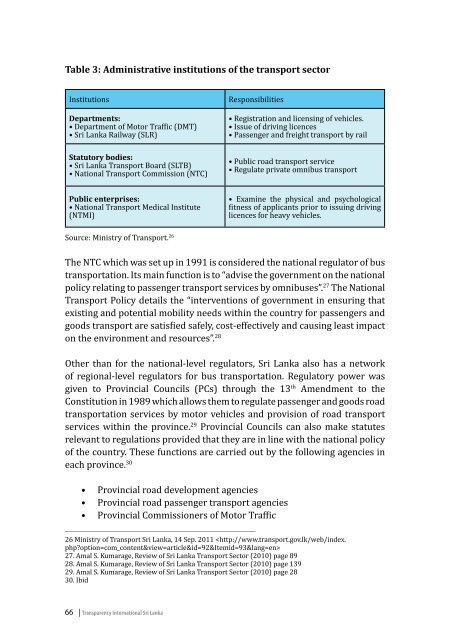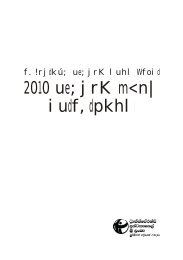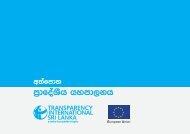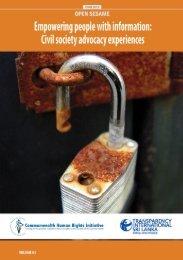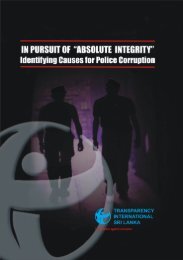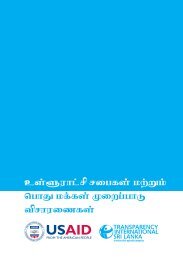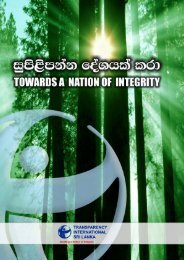Governance Report 2011 - Transparency International Sri Lanka
Governance Report 2011 - Transparency International Sri Lanka
Governance Report 2011 - Transparency International Sri Lanka
Create successful ePaper yourself
Turn your PDF publications into a flip-book with our unique Google optimized e-Paper software.
Table 3: Administrative institutions of the transport sector<br />
Institutions<br />
Departments:<br />
• Department of Motor Traffic (DMT)<br />
• <strong>Sri</strong> <strong>Lanka</strong> Railway (SLR)<br />
Statutory bodies:<br />
• <strong>Sri</strong> <strong>Lanka</strong> Transport Board (SLTB)<br />
• National Transport Commission (NTC)<br />
Responsibilities<br />
• Registration and licensing of vehicles.<br />
• Issue of driving licences<br />
• Passenger and freight transport by rail<br />
• Public road transport service<br />
• Regulate private omnibus transport<br />
Public enterprises:<br />
• National Transport Medical Institute<br />
(NTMI)<br />
• Examine the physical and psychological<br />
fitness of applicants prior to issuing driving<br />
licences for heavy vehicles.<br />
Source: Ministry of Transport. 26<br />
The NTC which was set up in 1991 is considered the national regulator of bus<br />
transportation. Its main function is to “advise the government on the national<br />
policy relating to passenger transport services by omnibuses”. 27 The National<br />
Transport Policy details the “interventions of government in ensuring that<br />
existing and potential mobility needs within the country for passengers and<br />
goods transport are satisfied safely, cost-effectively and causing least impact<br />
on the environment and resources”. 28<br />
Other than for the national-level regulators, <strong>Sri</strong> <strong>Lanka</strong> also has a network<br />
of regional-level regulators for bus transportation. Regulatory power was<br />
given to Provincial Councils (PCs) through the 13 th Amendment to the<br />
Constitution in 1989 which allows them to regulate passenger and goods road<br />
transportation services by motor vehicles and provision of road transport<br />
services within the province. 29 Provincial Councils can also make statutes<br />
relevant to regulations provided that they are in line with the national policy<br />
of the country. These functions are carried out by the following agencies in<br />
each province. 30<br />
• Provincial road development agencies<br />
• Provincial road passenger transport agencies<br />
• Provincial Commissioners of Motor Traffic<br />
26 Ministry of Transport <strong>Sri</strong> <strong>Lanka</strong>, 14 Sep. <strong>2011</strong> <br />
27. Amal S. Kumarage, Review of <strong>Sri</strong> <strong>Lanka</strong> Transport Sector (2010) page 89<br />
28. Amal S. Kumarage, Review of <strong>Sri</strong> <strong>Lanka</strong> Transport Sector (2010) page 139<br />
29. Amal S. Kumarage, Review of <strong>Sri</strong> <strong>Lanka</strong> Transport Sector (2010) page 28<br />
30. Ibid<br />
66 | <strong>Transparency</strong> <strong>International</strong> <strong>Sri</strong> <strong>Lanka</strong>


